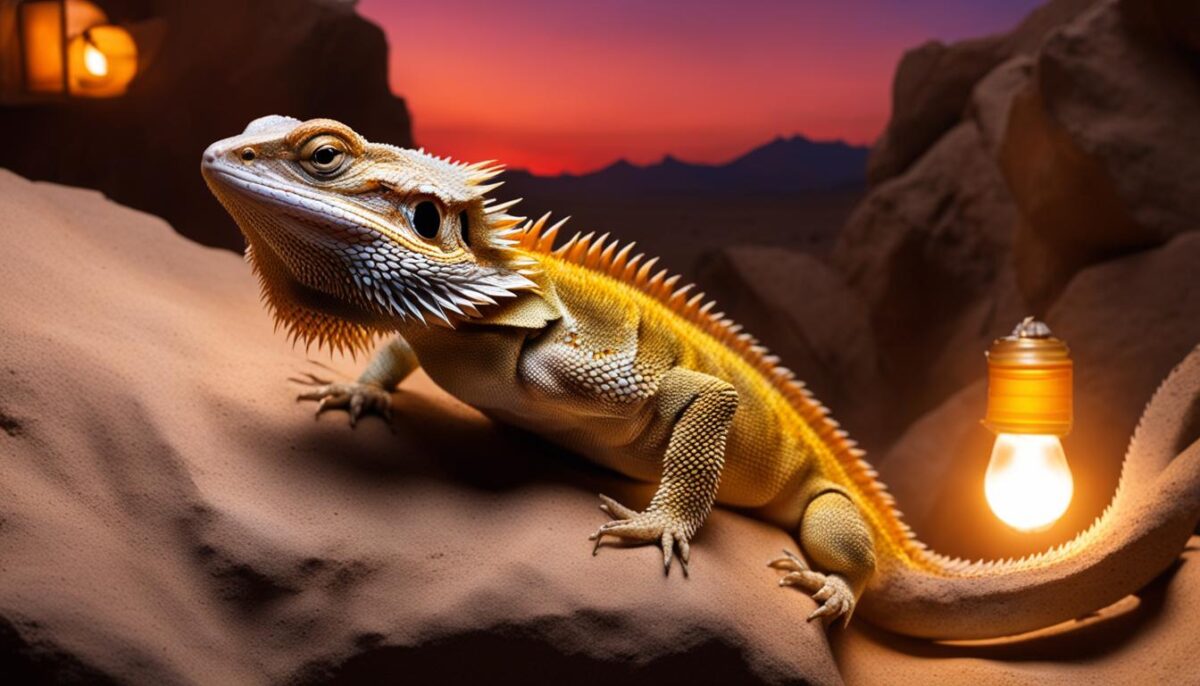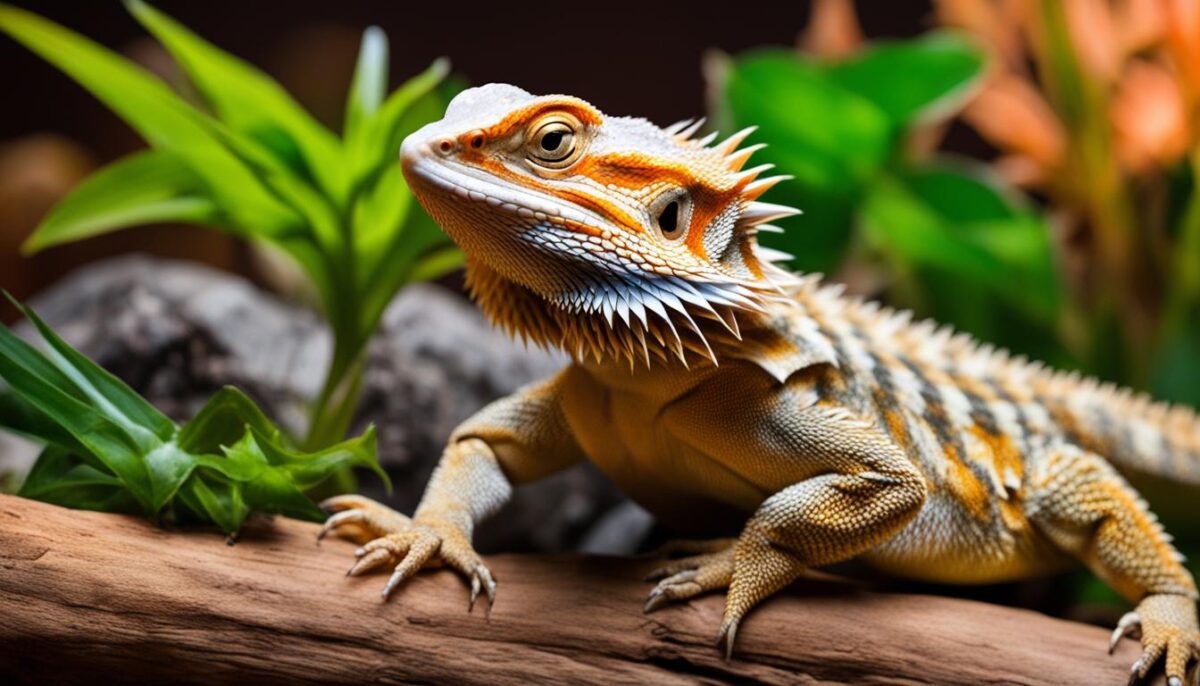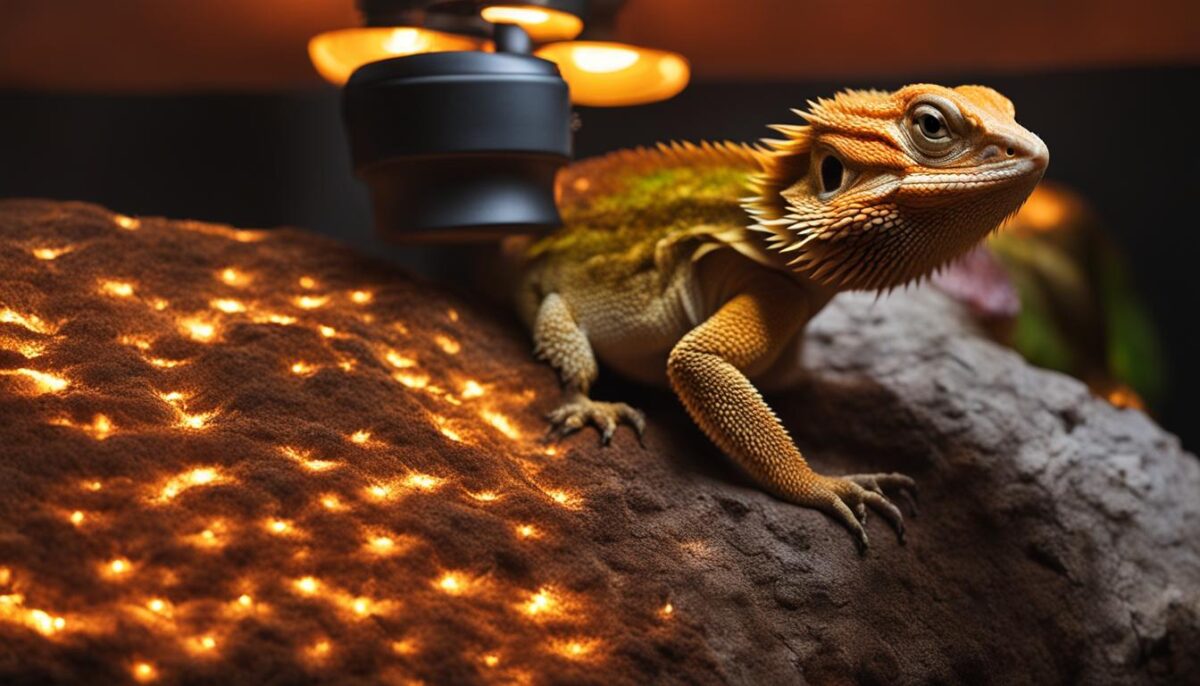In this comprehensive guide, we will provide all the information you need to ensure optimal heat for your bearded dragon using a 150 watt bulb. We will cover topics such as bearded dragon care, growth, diet, size, lifespan, health, behavior, and habitat. This guide is essential for any bearded dragon owner who wants to create the perfect environment for their pet.
Key Takeaways:
- Proper heat is crucial for the health of your bearded dragon.
- Using a 150 watt bulb can help maintain optimal temperatures in your dragon’s habitat.
- Bearded dragon care, diet, and habitat all play a role in creating the ideal environment.
- Maintaining proper cage temperatures is essential for your dragon’s well-being.
- Monitor the basking temperature and provide a temperature gradient in the cage.
What Lighting Does a Bearded Dragon Need?
Proper lighting plays a crucial role in the health and well-being of your bearded dragon. To create the optimal lighting setup, you will need a basking bulb, a UVB bulb, and a ceramic heat emitter. These bulbs should be set up using the right fixtures to ensure the safety of your pet.
When it comes to the basking bulb, it is recommended to use a bright white light that emits heat. This bulb should be positioned in a way that provides a designated basking spot for your bearded dragon, mimicking the warmth they would experience in their natural habitat. The recommended wattage for the basking bulb depends on the size of your dragon’s enclosure, with larger enclosures requiring higher wattage for the desired temperature.
Alongside the basking bulb, a UVB bulb is essential for your bearded dragon’s health. UVB light helps them produce vitamin D3, which aids in calcium absorption, vital for strong bones and overall health. Make sure to choose a UVB bulb specifically designed for reptiles, as they emit the appropriate wavelengths necessary for vitamin D3 synthesis.
Lastly, the ceramic heat emitter is used to provide additional heat without emitting light. This is particularly useful during the nighttime when bearded dragons need darkness to sleep. The ceramic heat emitter can be used as an alternative heat source if your home temperature drops below 65 degrees Fahrenheit, helping to maintain the proper cage temperature.
| Lighting Component | Recommended Type |
|---|---|
| Basking Bulb | Bright white heat-emitting bulb |
| UVB Bulb | Reptile-specific UVB bulb |
| Ceramic Heat Emitter | Nighttime heat source (if required) |
It is important to note that bearded dragons do not require any type of nightlight or additional lighting at night. They need a period of darkness to maintain their natural sleep cycle. By providing the right lighting setup during the day and allowing for natural darkness at night, you can ensure the well-being of your bearded dragon.
Bearded Dragon Lighting Schedule
Establishing a proper lighting schedule for your bearded dragon is crucial for their overall health and well-being. The lighting schedule not only provides the necessary heat and UVB rays, but it also helps regulate their internal body clock and supports important biological functions. Here is a breakdown of the key aspects to consider when creating a lighting schedule for your bearded dragon:
UVB and Heat Duration
Bearded dragons require exposure to UVB light for a specific duration each day to help them metabolize calcium and support proper bone development. It is recommended to provide 10 to 12 hours of UVB light per day. The heat lamp, on the other hand, should be provided for around 12 to 14 hours each day to maintain the basking spot temperature. This duration mimics the natural daylight and temperature cycles that bearded dragons experience in the wild.
Brumation
Brumation is a period of dormancy that some bearded dragons go through during the winter months. During this time, they may reduce their activity levels, eat less, and sleep more. It is important to adjust the lighting schedule during brumation to match this natural behavior. Gradually decrease the hours of daylight and adjust the heat lamp accordingly to reflect the change in seasons. Always monitor your dragon closely during this time and consult with a reptile veterinarian if you have any concerns.
Feeding Schedule and Digestion
When it comes to feeding your bearded dragon, it is best to turn on the lights before offering food. Bearded dragons are more likely to eat when they are presented with food under proper lighting conditions. Additionally, leaving the lights on for a while after feeding can aid in digestion. This helps the dragon’s body process and absorb the nutrients from their meal more efficiently. It is essential to maintain consistent feeding times and ensure the lights are on during these periods to support their feeding habits.
| Lighting Schedule Guidelines | Duration |
|---|---|
| UVB Light | 10 to 12 hours per day |
| Heat Lamp | 12 to 14 hours per day |
| Brumation Period | Gradually decrease light and heat duration to match natural behavior |
| Feeding Schedule | Turn on lights before feeding and leave them on for a while after to aid digestion |
By following a proper lighting schedule, you can ensure that your bearded dragon receives the necessary light and heat required for their growth, development, and overall health. Remember to regularly monitor the temperatures in their habitat and make adjustments as needed. Consulting with a reptile veterinarian or a knowledgeable bearded dragon owner can also provide additional guidance specific to your dragon’s needs.
Bearded Dragon Cage Temperatures
Proper cage temperatures are crucial for the health and well-being of your bearded dragon. It’s important to create a temperature gradient within the enclosure to allow your dragon to regulate its body temperature effectively. This gradient consists of a basking spot, warm side, and cool side.
The basking spot is the area where your dragon can get the highest temperature in the cage. It should be around 100-110°F (37-43°C) for adult dragons, while for juveniles and hatchlings, the basking spot temperature should be slightly lower at around 95-105°F (35-40°C). This high heat helps your dragon digest its food properly and provides the necessary warmth to maintain its overall health.
The warm side of the cage, away from the basking spot, should have a temperature of around 85-95°F (29-35°C) for adult dragons and 80-90°F (27-32°C) for juveniles and hatchlings. This area serves as a comfortable space for your dragon to rest and regulate its body temperature when it doesn’t require the intense heat of the basking spot.
The cool side of the cage should have a temperature between 75-85°F (24-29°C) for adult dragons and 70-80°F (21-27°C) for juveniles and hatchlings. This cooler area allows your dragon to cool down when it feels too warm and helps prevent overheating. Having a temperature gradient in the cage ensures that your bearded dragon can move around and choose the right spot to maintain its preferred body temperature.
Remember, accurate temperature measurements are essential. Use a reliable thermometer to monitor the temperatures in different areas of the enclosure regularly. This will help you ensure that your bearded dragon is always in a comfortable and healthy environment.
Ideal Bearded Dragon Basking Temp
When it comes to the health and well-being of your bearded dragon, maintaining the ideal basking temperature is crucial. The basking spot provides your dragon with the necessary heat to regulate its body temperature, aid in digestion, and stimulate appetite. However, it’s important to note that the ideal basking temperature can vary based on the age of your dragon.
Age-Specific Basking Temperatures
| Age Group | Ideal Basking Temperature |
|---|---|
| Adult Dragons | 100-110°F (37-43°C) |
| Juveniles | 105-115°F (40-46°C) |
| Hatchlings | 110-120°F (43-49°C) |
It’s important to monitor the basking temperature regularly to ensure it remains within the appropriate range for your dragon’s age group. A thermometer placed at the basking spot can help you keep track of the temperature effectively. Remember that providing the correct basking temperature is essential for your dragon’s overall health and can prevent issues such as stunted growth and metabolic bone disease.
Creating a gradient within the enclosure is also important. This allows your dragon to move between the basking spot and cooler areas, regulating its body temperature as needed. Make sure to provide a warm side with temperatures around 85-90°F (29-32°C) and a cool side with temperatures around 75-80°F (24-27°C). This temperature gradient will allow your dragon to thermoregulate effectively.
By maintaining the ideal basking temperature and creating a suitable temperature gradient within the enclosure, you can provide your bearded dragon with the optimal conditions for its health and well-being.

Do Bearded Dragons Need a Heat Lamp At Night?
In order to create a suitable habitat for your bearded dragon, it’s essential to understand their heating requirements both during the day and at night. While bearded dragons require a heat lamp during the day to maintain their body temperature, they do not need any form of lighting, including a heat lamp, at night. This is because bearded dragons are diurnal creatures, meaning they are active during the day and sleep at night. Providing a dark, quiet environment at night allows them to maintain their natural sleep-wake cycle and promotes their overall well-being.
Unlike some other reptiles, bearded dragons do not require specific nighttime heating. They are able to tolerate slightly cooler temperatures during the night as long as their overall habitat remains within the appropriate temperature range. It’s important to monitor the temperature in their cage at night to ensure it does not drop below 65 degrees Fahrenheit. If your home temperature falls below this threshold, it’s recommended to use a ceramic heat emitter as an alternative heat source to maintain a suitable temperature for your dragon.
By providing a dark and quiet environment at night, you are allowing your bearded dragon to rest and rejuvenate. This is crucial for their overall health and well-being. Remember to always monitor the temperature in their cage and make adjustments as necessary. With the right care and attention to their heating requirements, you can ensure your bearded dragon remains comfortable and happy.
Table: Comparison of Daytime and Nighttime Heating Requirements
| Heating Requirement | Daytime | Nighttime |
|---|---|---|
| Heat Lamp | Required for maintaining body temperature | Not necessary |
| Lighting | Required for simulating daylight | Not necessary |
| Ceramic Heat Emitter | Not necessary | Alternative heat source if temperature drops below 65°F |
| Sleep-Wake Cycle | Diurnal (active during the day, sleep at night) | Diurnal (active during the day, sleep at night) |
What Happens If a Bearded Dragon Gets Too Cold?
Keeping your bearded dragon at the proper temperature is crucial for their health and well-being. If your dragon gets too cold, it can have serious effects on their overall condition. Here are some of the common consequences of exposing your bearded dragon to cold temperatures:
- Lethargy: When bearded dragons are too cold, they become sluggish and inactive. They may spend more time sleeping and show a lack of interest in their surroundings.
- Lack of appetite: Cold temperatures can also lead to a decrease in appetite. Your bearded dragon may refuse to eat or show a significant decrease in their food intake.
- Metabolic bone disease: Prolonged exposure to cold temperatures can increase the risk of metabolic bone disease in bearded dragons. This condition affects their bone health and can lead to deformities and other serious complications.
It’s important to note that bearded dragons are ectothermic reptiles, meaning they rely on external heat sources to regulate their body temperature. They cannot generate their own heat like mammals do. Therefore, it is necessary to provide them with a warm environment to ensure their physiological functions operate optimally.
If you notice any of these symptoms in your bearded dragon, it’s crucial to take immediate action to warm them up. You can provide additional heat by adjusting the temperature in their enclosure or offering a warm place for them to bask. It’s also recommended to consult with a reptile veterinarian for further guidance if you suspect your bearded dragon has been exposed to cold temperatures for a prolonged period.
| Cold Effects | Symptoms |
|---|---|
| Lethargy | Sluggishness, increased sleep, lack of interest in surroundings |
| Lack of appetite | Refusal to eat, decreased food intake |
| Metabolic bone disease | Increased risk of bone deformities and complications |
Remember, providing the proper temperature and environment for your bearded dragon is essential for their overall well-being. By ensuring they have access to adequate warmth, you can help prevent these cold-related issues and promote a happy, healthy life for your pet.

How Many Watts Is Good For A Bearded Dragon?
Providing the appropriate wattage for your bearded dragon is crucial in maintaining their optimal heat levels. The general rule of thumb is to aim for 40-50 watts per square foot of the tank. Consider the size of your tank when determining the wattage needed. It’s important to note that wattage alone does not determine the temperature, but it is a key factor in achieving the desired basking area temperature.
The basking area is where your bearded dragon will spend a significant amount of time to regulate their body temperature. This spot should have a higher temperature than the rest of the tank, usually around 95-105 degrees Fahrenheit (35-40 degrees Celsius). Using a higher wattage bulb in the basking area will help achieve this temperature range. However, always monitor the actual temperature in the basking area using a reliable thermometer to ensure it remains within the recommended range.
While it’s important to provide a suitable wattage for the basking area, don’t forget about the cool side of the tank. The cool side should be slightly lower in temperature, around 80-85 degrees Fahrenheit (27-29 degrees Celsius). This temperature difference allows your bearded dragon to thermoregulate and move between warmer and cooler areas as needed. Adjusting the wattage or placing light fixtures closer or farther from the basking area can help achieve the desired temperatures in different parts of the tank.
| Area | Temperature Range |
|---|---|
| Basking Area | 95-105°F (35-40°C) |
| Cool Side | 80-85°F (27-29°C) |
Remember, maintaining proper temperatures is crucial for the health and well-being of your bearded dragon. Always monitor the temperatures using a reliable thermometer and adjust the wattage or positioning of light fixtures accordingly. By providing the right amount of wattage, you can ensure that your bearded dragon has the optimal heat they need to thrive.

Conclusion
In conclusion, this bearded dragon care guide has provided comprehensive information on optimal heat, bearded dragon lighting, and temperature control. By following the guidelines outlined in this guide, you can ensure the well-being of your bearded dragon.
Proper lighting is crucial for your bearded dragon’s health. Using a basking bulb, UVB bulb, and ceramic heat emitter with the right fixtures will create the ideal lighting setup. Remember to use white light for the heat lamp and avoid using any type of nightlight.
Establishing a lighting schedule is equally important. Providing the appropriate duration of UVB and heat, turning on the lights before feeding, and leaving them on for digestion stimulation are all key factors in your dragon’s overall health.
In addition to lighting, maintaining proper cage temperatures is essential. Create a temperature gradient with a basking spot, warm side, and cool side. Measure the temperatures accurately and ensure they fall within the ideal range for your dragon’s age group.
Remember, regular monitoring of temperature, lighting, and overall care is vital to your bearded dragon’s well-being. By providing optimal heat, proper lighting, and temperature control, you can create a safe and comfortable environment for your beloved pet.
FAQ
What is the proper lighting setup for a bearded dragon?
The proper lighting setup for a bearded dragon includes a basking bulb, a UVB bulb, and a ceramic heat emitter. These bulbs should be set up using the appropriate fixtures.
Can you recommend specific bulbs for a bearded dragon?
We recommend using a 150 watt basking bulb, a UVB bulb with a high UVB output, and a ceramic heat emitter for nighttime heating.
Does my bearded dragon need any type of nightlight?
No, bearded dragons do not need any lights, including a heat lamp, at night. It is unnecessary and can disrupt their natural sleep cycles.
What are the effects of cold temperatures on a bearded dragon?
Cold temperatures can have serious health consequences for a bearded dragon. Some effects include lethargy, lack of appetite, and the risk of developing metabolic bone disease.
How many watts should I use for my bearded dragon’s heat lamp?
As a general rule, you should use 40-50 watts per square foot of tank space. Adjust the wattage according to the size of your tank.

